Research on the Spatial Pattern Characteristics of the Taihu Lake “Dock Village” Based on Microclimate: A Case Study of Tangli Village
Abstract
1. Introduction
2. Material and Methods
2.1. Study Area
2.2. Data Source and Processing
2.2.1. Stereopair Data
2.2.2. Building Height Measurement Data
2.2.3. Meteorological Data
2.3. Research Methods
3. Results and Analysis
3.1. Simulation Accuracy Analysis
3.2. Microclimate Simulation Results
3.3. Summary and Discussion
3.3.1. Effects of Planar Spatial Patterns on Microclimate
3.3.2. Effects of Cross-Section Spatial Pattern on Microclimate
3.3.3. Effects of Vertical-Section Spatial Pattern on Microclimate
3.3.4. The Relationship between Spatial Distribution Trend of Linear Development and Microclimate
4. Conclusions and Future Prospects
- (1)
- From an overall point of view, the flat space of Tangli Village is characterized by having a wide middle and being narrow at both ends. The internal structure is a “small aggregation, large dispersion” patch pattern. This planar feature can not only reduce heat loss in winter, but also improve the wind environment inside the village in summer.
- (2)
- The cross-section spatial pattern of Tangli Village conforms to the situation of the mountain, and ingeniously utilizes the gap of the terrain. In this elevation space, the Mountainvalley breeze can form, which can not only reduce the temperature difference between day and night, but also improve the wind environment in the east-west direction of the village.
- (3)
- The vertical-section spatial pattern of Tangli village forms the model of “mountain-forest-land-village-farmland-lake”, which can not only effectively utilize land, but also resist the cold current coming from Taihu Lake in winter and improve the microclimate at the main entrance of the village.
- (4)
- The linear development spatial pattern of Tangli Village refers to the gradual outward expansion of buildings along the main rivers, roads, surface runoff and contours. This spatial development model fully adapts to the changes and impacts of the microclimate, which shows good microclimate adaptability.
Author Contributions
Funding
Conflicts of Interest
References
- Wu, Q.; Han, L.; Zhu, L.; Chen, F. Layout Analyses of Wuyuan Ancient Villages. Planners 2010, 4, 84–89. [Google Scholar]
- Sun, S.L.; Li, X.; Song, S. A Study of Landscape Pattern Characteristics and Ecological Adaptability of Bouyei Stone House Group. J. Chin. Urban For. 2017, 15, 26–30. [Google Scholar] [CrossRef]
- Yuri-Ling, H.E.; Zhang, Y.P.; Liu, Y.H.; You-Xin, M.A.; You-Rong, L.I.; Dou, J.X.; Guo, P. A Study on the Horizonal-Spatial Characteristics of Urban Climate in Kunming City. Sci. Geogr. Sin. 2002, 22, 724–729. [Google Scholar]
- Ni, X. Myanmar Wenxuan Meditation Center Design Based on Microclimate of Gardens; Tsinghua University: Beijing, China, 2012. [Google Scholar]
- Leng, H.; Yuan, Q. International Experience and Enlightenment on Urban Microclimate Environment Control and Optimization. Urban Plan. Int. 2014, 29, 114–119. [Google Scholar]
- Xiong, Y.; Wang, Y.; Zhao, C.; Chen, C.; Shi, Y. Space Form of Classical Southern China Gardens Based on Micro-climate Improvement. J. Northwest For. Univ. 2015, 30, 295–300. [Google Scholar] [CrossRef]
- Huang, L.M.; Li, J.L.; Zhao, D.; Zhu, J. A fieldwork study on the diurnal changes of urban microclimate in four types of ground cover and urban heat island of Nanjing, China. Build. Environ. 2008, 43, 7–17. [Google Scholar] [CrossRef]
- Sun, J.; Feng, J.; Duan, W. Change in the Urban Heat Island Effect in Kunming. Clim. Environ. Res. 2015, 20, 645–653. [Google Scholar] [CrossRef]
- Vogt, J.V.; Viau, A.A.; Paquet, F. Mapping regional air temperature fields using satellite-derived surface skin temperatures. Int. J. Climatol. 1997, 17, 1559–1579. [Google Scholar] [CrossRef]
- Kolokotroni, M.; Giridharan, R. Urban heat island intensity in London: An investigation of the impact of physical characteristics on changes in outdoor air temperature during summer. Sol. Energy 2008, 82, 986–998. [Google Scholar] [CrossRef]
- Wang, W.-W.; Li, G.-L.; Xue, J. Spatial distribution of urban heat island in Hangzhou and its mitigation countermeasures. J. Nat. Dis. 2009, 18, 14–20. [Google Scholar] [CrossRef]
- Zhu, S.; Zhang, G.; Liu, Y. Change of Underlying Surface Pattern and Its Local Thermal Environment Effect in Suzhou City. Sci. Geogr. Sin. 2012, 32, 859–865. [Google Scholar] [CrossRef]
- Liu, Y.H.; Quan, W.J. Research on High Temperature Indices of Beijing City and Its Spatiotemporal Pattern Based on Satellite Data. Clim. Environ. Res. 2014, 19, 332–342. [Google Scholar] [CrossRef]
- Zhang, H.L.; Zhu, S.Y.; Wang, M.J.; Zhang, Z.Y. Sky View Factor Estimation based on 3D Urban Building Data and Its Application in Urban Heat island—Illustrated by the Case of Adelaide. Remote Sens. Technol. Appl. 2015, 30, 899–907. [Google Scholar] [CrossRef]
- Max, T.A.; Morris, E.N. Building, Climate, Energy; China Architecture & Building Press: Beijing, China, 1990; ISBN 978-7-112-00723-3. [Google Scholar]
- Chen, Z.L. Research of Vegetation System’s Effects on Outdoor Thermal Environment of Residential Communities in Hot-Humid Climate; South China University of Technology: Guangzhou, China, 2010. [Google Scholar]
- Wang, Z. Design Strategies for the Climate Adaptability of Street Canyon Based on Urban Microclimate in Hot-Summer and Cold-Winter Zone; Huazhong University of Science & Technology: Wuhan, China, 2008. [Google Scholar]
- Lin, B.R. Studies of Greening’s Effects on Outdoor Thermal Environment; Tsinghua University: Beijing, China, 2004. [Google Scholar]
- Krüger, E.L.; Minella, F.O.; Rasia, F. Impact of urban geometry on outdoor thermal comfort and air quality from field measurements in Curitiba, Brazil. Build. Environ. 2011, 46, 621–634. [Google Scholar] [CrossRef]
- Pearlmutter, D.; Bitan, A.; Berliner, P. Microclimatic analysis of “compact” urban canyons in an arid zone. Atmos. Environ. 1999, 33, 4143–4150. [Google Scholar] [CrossRef]
- Ali-Toudert, F.; Mayer, H. Numerical study on the effects of aspect ratio and orientation of an urban street canyon on outdoor thermal comfort in hot and dry climate. Build. Environ. 2006, 41, 94–108. [Google Scholar] [CrossRef]
- Ng, E.; Chen, L.; Wang, Y.; Yuan, C. A study on the cooling effects of greening in a high-density city: An experience from Hong Kong. Build. Environ. 2012, 47, 256–271. [Google Scholar] [CrossRef]
- Salata, F.; Golasi, I.; de Lieto Vollaro, R.; de Lieto Vollaro, A. Urban microclimate and outdoor thermal comfort. A proper procedure to fit ENVI-met simulation outputs to experimental data. Sustain. Cities Soc. 2016, 26, 318–343. [Google Scholar] [CrossRef]
- Li, J.J.; Wang, J.G. Simulation analysis on relationship between spatial form and microclimate of pedestrian street in Nanjing. J. Southeast Univ. 2016, 46, 1103–1109. [Google Scholar] [CrossRef]
- Sun, X.; Yang, J.Y.; Wen, S.S. Study on Spatial Form and Thermal Environment of Urban Central District Based on ENVI-met Simulation: A Case Study of Xinjiekou, Nanjing. In Urban Ecological Planning; China Architecture & Building Press: Shenyang, China, 2016. [Google Scholar]
- Lao, Z.-M.; Li, Y.-M.; Deng, X.; Li, Y.-X. Numerical simulation of thermal environment in Zhongshan urban streets based on ENVI-met. China Environ. Sci. 2017, 37, 3523–3531. [Google Scholar]
- Yue, X.Q.; Yi, H.W.; Kong, F.H.; Chen, J.Y.; Liu, M.Q. The Influence of Green Space Layout on Microclimate based on ENVI-met: A Case Study of the Residential District in Nanjing. Jiangsu Urban Plan. 2018, 3, 34–40. [Google Scholar]
- Zhan, H. The Analysis of Temporal and Spatial Variation of Three-Dimensional Vegetation Temperature Fields Based on the ENVI-Met Model; Beijing Forestry University: Beijing, China, 2014. [Google Scholar]
- Zhang, L.; Zhan, Q.; Lan, Y. Study on Cooling Effect of Residential Green Space in Wuhan. Chin. Landsc. Archit. 2018, 34, 47–53. [Google Scholar]
- Xiaohan, L.I.; Dan, H.U.; Yuanzheng, L.I.; Zhou, H. The impact of central green space layout on micrometeorology in high residential community. Ecol. Sci. 2017, 36, 202–209. [Google Scholar] [CrossRef]
- Guo, S.M.; Liu, Y.J.; Wang, W. Analyzing the Association of Village Landscape Elements and Micro-climate Adaptability—Based on Guishan Village in Huai’an. In Digital Culture; China Architecture & Building Press: Nanjing, China, 2017. [Google Scholar]
- Han, L.I.; Jia-Zheng, W.U.; Zhao, Y.F.; Huang, J.; Zheng-Wei, L.I.; Ying-Jun, R. Influence Analysis of Building Layouts on Micro-environment of Residence Community. Build. Energy Effic. 2016, 44, 57–63. [Google Scholar] [CrossRef]
- Yang, X.; Chen, Z.; Shangguan, L.; Xiao, Q.; Wang, X. Research on the Impact of Underground Parking to the Microclimate in Residential Quarter. Chin. J. Undergr. Space Eng. 2016, 12, 11–19. [Google Scholar] [CrossRef]
- Qin, W.C.; Dan, H.U.; Yuan-Zheng, L.I.; Guo, Z. Numerical simulation of microclimate in Beijing typical residential area based on ENVI-met model. J. Meteorol. Environ. 2015, 56–62. [Google Scholar] [CrossRef]
- Liu, Z.; Zheng, S.; Fang, X.; Lu, X.; Zhao, L. Simulating validation of ENVI-met vegetation model to Ficus microcarpa in hot-humid region of subtropical zone. J. Beijing For. Univ. 2018, 40. [Google Scholar] [CrossRef]
- Yang, X.; Xinsheng, L.U. Urban Landscape Planning Methods Based on ENVI-met Software Microclimate Simulation and Thermal Comfort: A Case Study of Bei Xin’an Area of Shijingshan District in Beijing. J. North China Univ. Technol. 2018, 30, 117–125. [Google Scholar]
- Yang, X.; He, S.; Lu, X. Research on Thermal Comfort Evaluation of Public Space in Beijing Old City Based on Software Simulation: A Case Study of Six Alleys in Baita Temple Area. Urban Archit. 2018, 6, 51–56. [Google Scholar]
- Tang, X.L.; Zhang, Z.R.; Yu, A.N. Landscape resource evaluation based on GIS-AHP analysis in Xishan traditional villages of Tai Lake. J. Gansu Agric. Univ. 2017, 52, 124–132. [Google Scholar]
- Suzhou City, Wuzhong District Xishan Town Chronicles Editorial Committee. Xishan Town Chronicles; Suzhou University Press: Suzhou, China, 2001. [Google Scholar]
- Zhu, S.; Gao, M.; Chen, T.; Zhang, G. Simulation and Analysis of Urban Near-Surface Air Temperature Based on ENVI-met Model: A Case Study in Some Areas of Nanjing. Clim. Environ. Res. 2017, 22, 499–507. [Google Scholar] [CrossRef]
- Bruse, M.; Fleer, H. Simulating surface–plant–air interactions inside urban environments with a three dimensional numerical model. Environ. Model. Softw. 1998, 13, 373–384. [Google Scholar] [CrossRef]
- Unger, J. Intra-urban relationship between surface geometry and urban heat island: Review and new approach. Clim. Res. 2004, 27, 253–264. [Google Scholar] [CrossRef]
- Ambrosini, D.; Galli, G.; Mancini, B.; Nardi, I.; Sfarra, S. Evaluating Mitigation Effects of Urban Heat Islands in a Historical Small Center with the ENVI-Met (R) Climate Model. Sustainability 2014, 6, 7013–7029. [Google Scholar] [CrossRef]
- Zhan, H.J.; Xie, W.J.; Sun, H.; Huang, H.G. Using ENVI-met model; sensitivity analysis; three-dimensional temperature field of vegetated scenes. J. Beijing For. Univ. 2014, 36, 64–74. [Google Scholar]
- Won, M.; Han, S. Simulations of Changes in Wind Field Over Mountainous Terrains Using WRF and ENVI-met Numerical Models. Korean J. Agric. For. Meteorol. 2013, 15, 17–25. [Google Scholar] [CrossRef]
- Kusumastuty, K.D.; Poerbo, H.W.; Koerniawan, M.D. Climate-sensitive urban design through Envi-Met simulation: Case study in Kemayoran, Jakarta. IOP Conf. Ser. Earth Environ. Sci. 2018, 129, 012036. [Google Scholar] [CrossRef]
- Xun, P.; Huang, S.; Chen, Z. Improvement Strategy for Outdoor Environment Quality in Commercial Street Based on ENVI-MET Simulation. Appl. Mech. Mater. 2014, 641–642, 1131–1136. [Google Scholar] [CrossRef]
- Pan, S. The Principle of Modern Climatology; China Meteorological Press: Beijing, China, 1994. [Google Scholar]
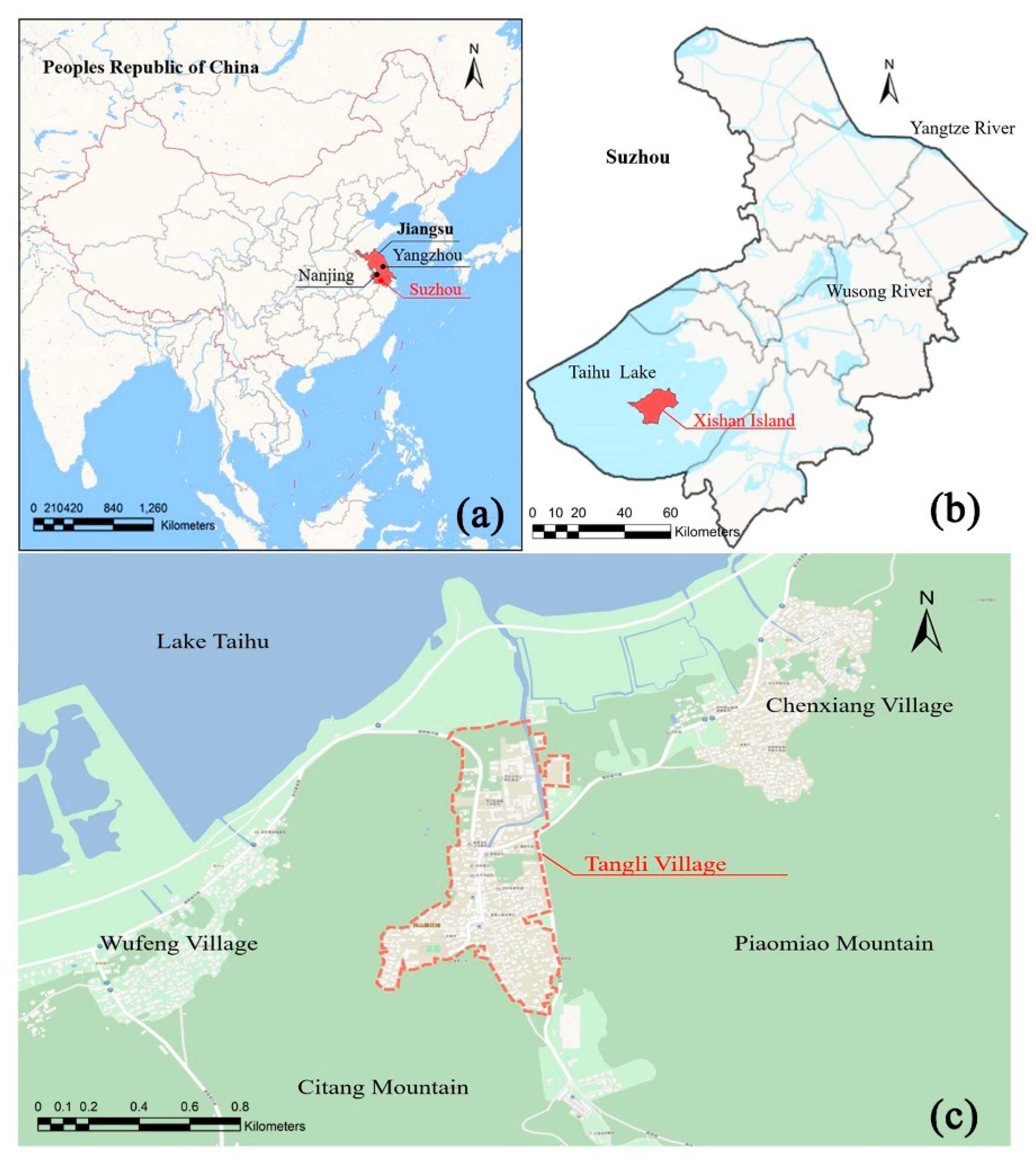
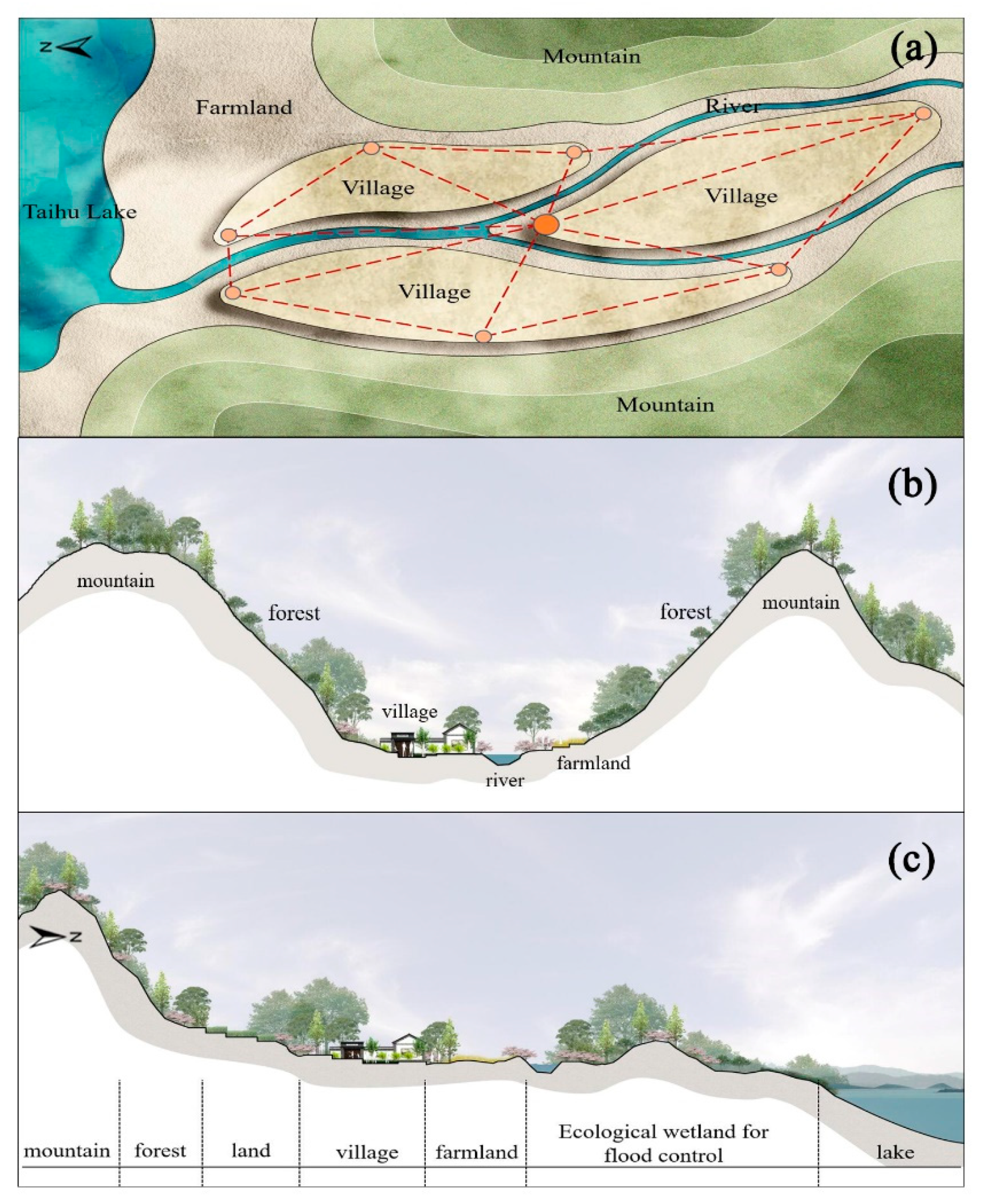
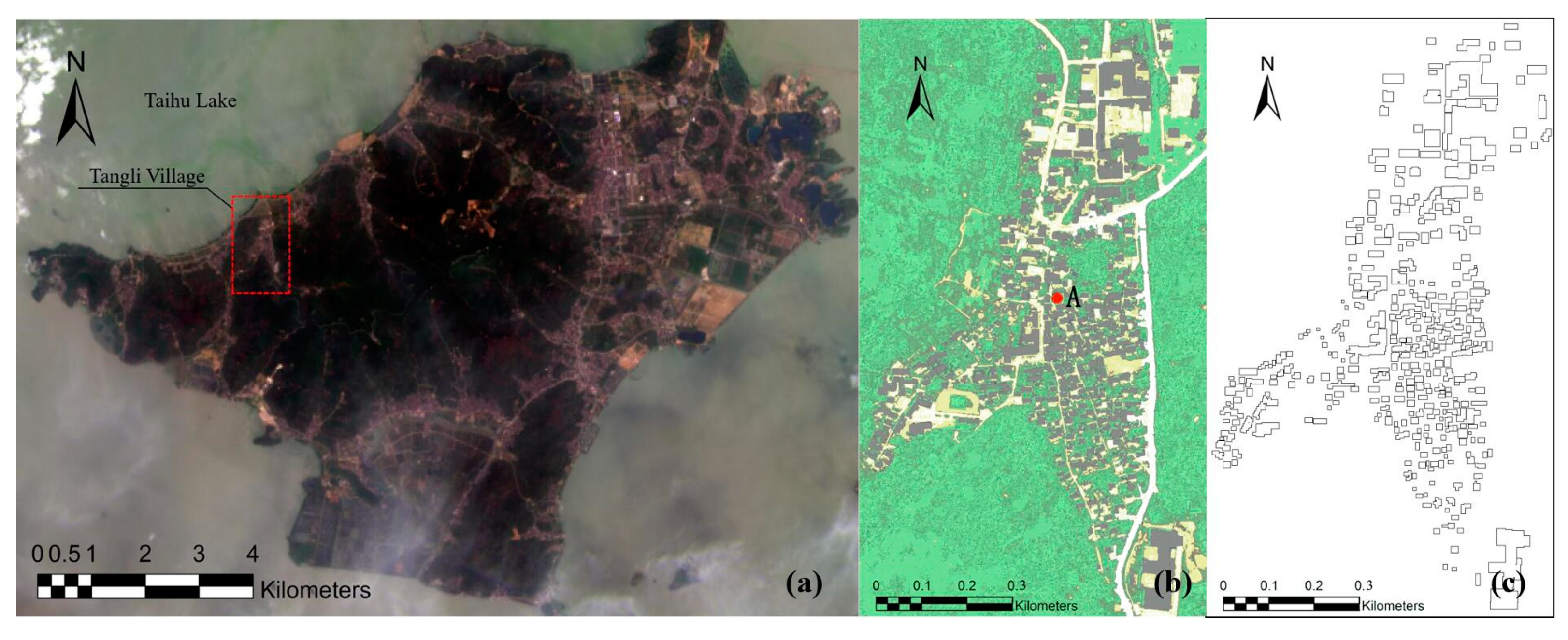

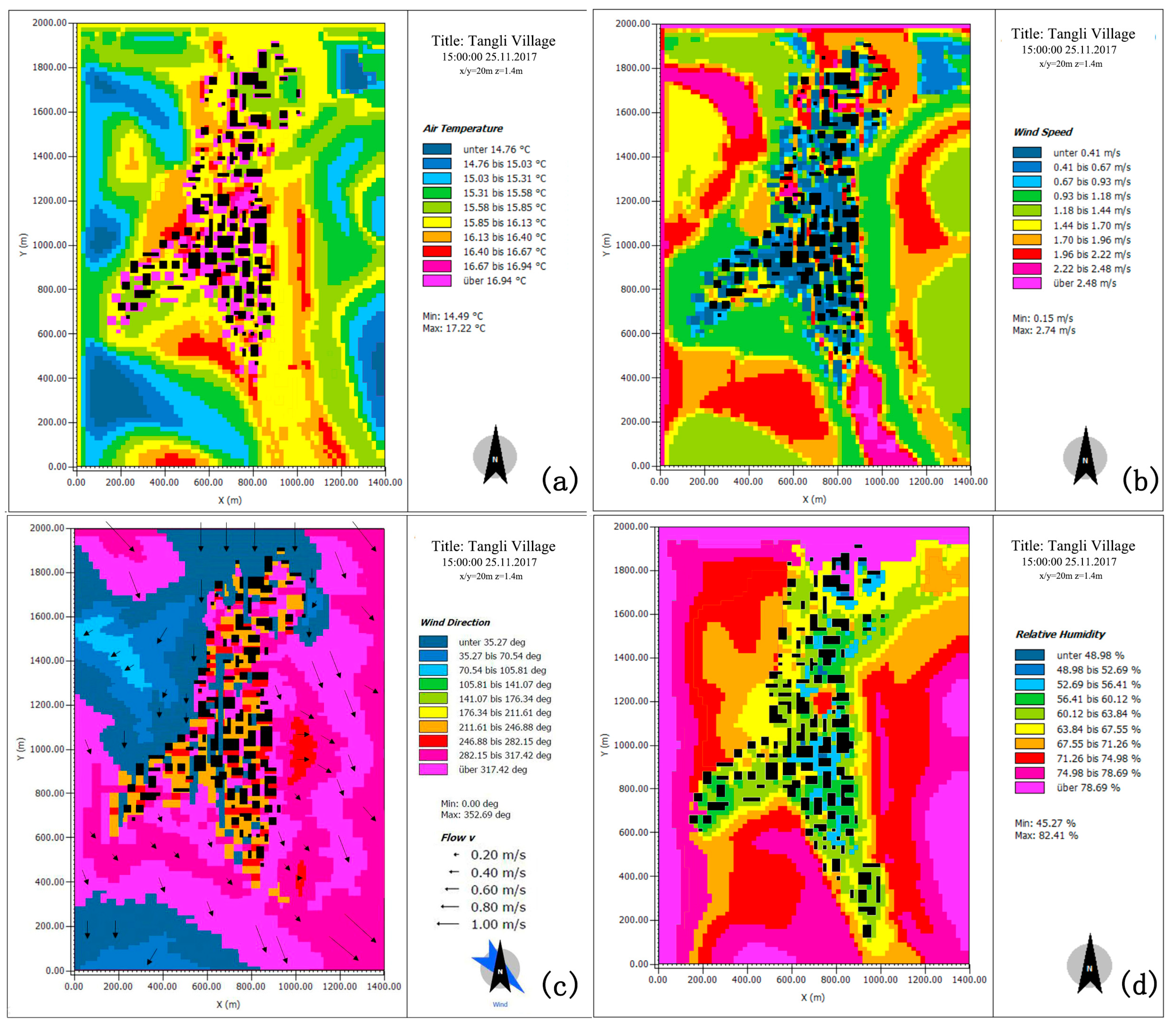


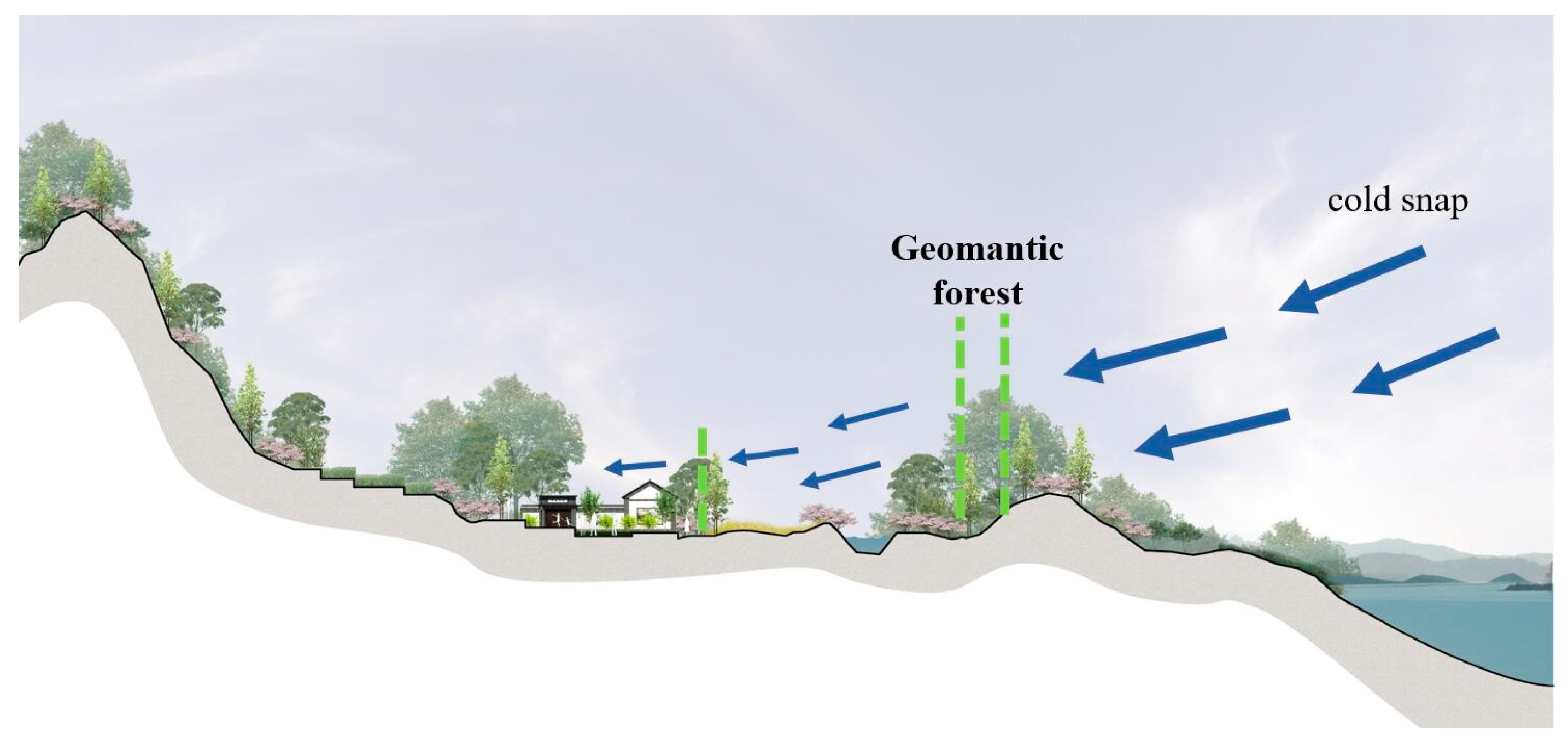
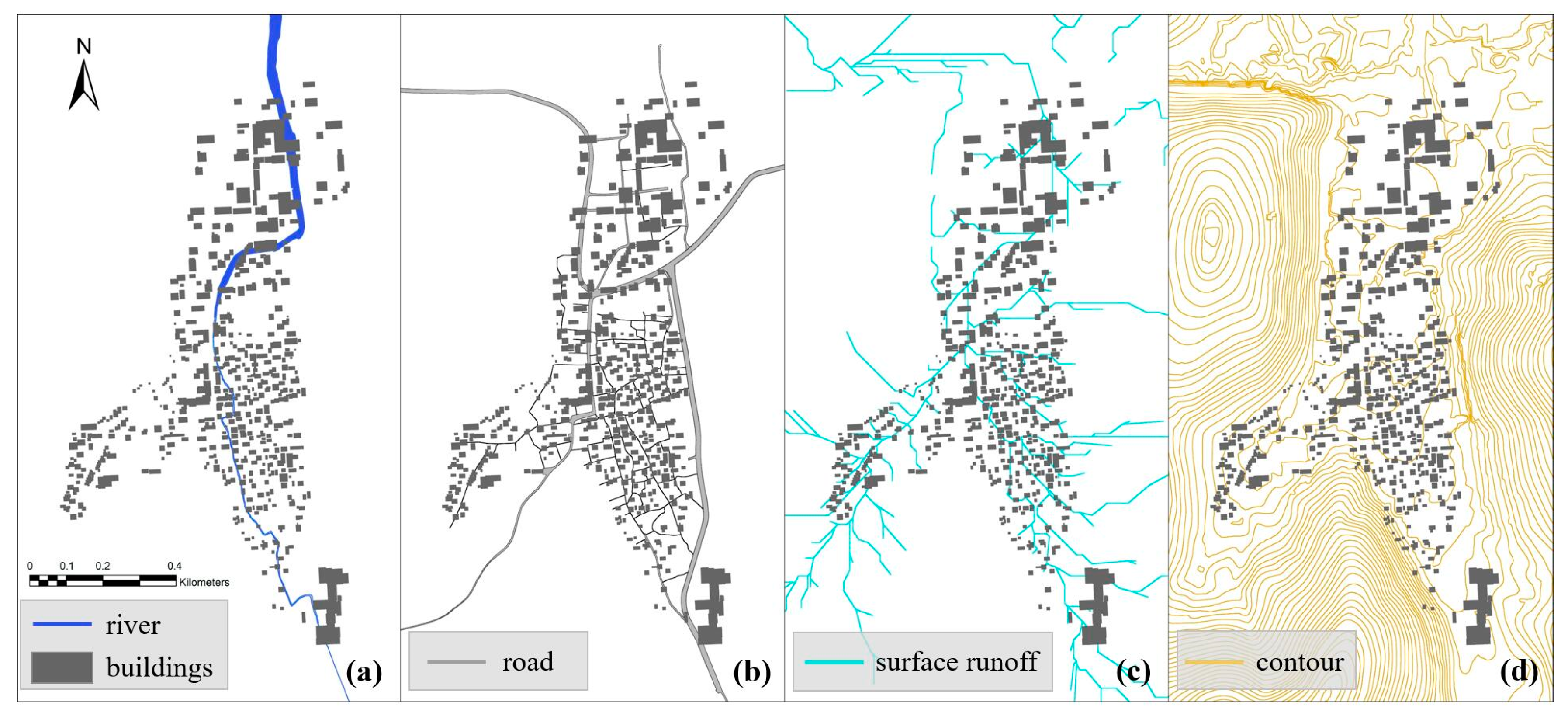
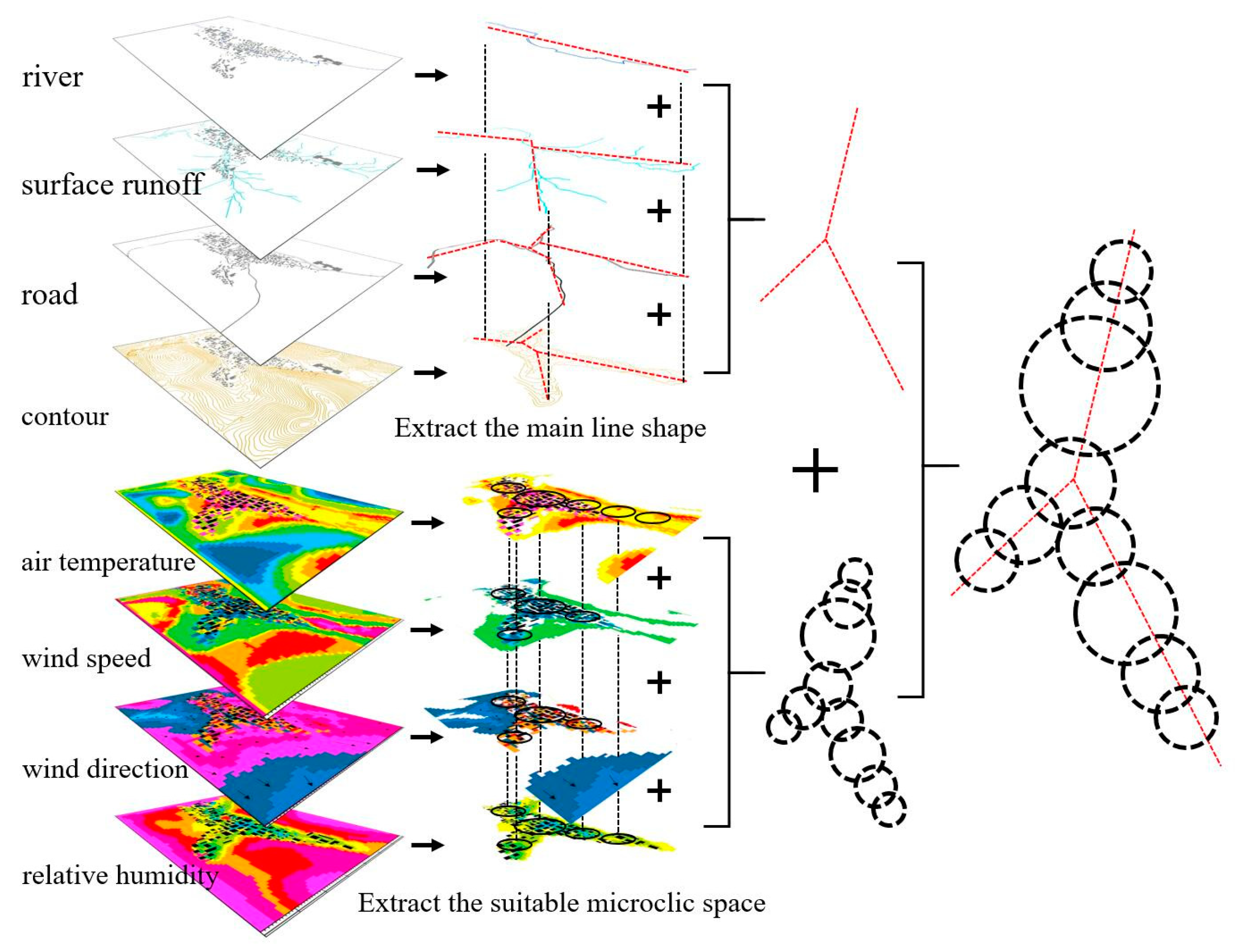
© 2019 by the authors. Licensee MDPI, Basel, Switzerland. This article is an open access article distributed under the terms and conditions of the Creative Commons Attribution (CC BY) license (http://creativecommons.org/licenses/by/4.0/).
Share and Cite
Ma, K.; Tang, X.; Ren, Y.; Wang, Y. Research on the Spatial Pattern Characteristics of the Taihu Lake “Dock Village” Based on Microclimate: A Case Study of Tangli Village. Sustainability 2019, 11, 368. https://doi.org/10.3390/su11020368
Ma K, Tang X, Ren Y, Wang Y. Research on the Spatial Pattern Characteristics of the Taihu Lake “Dock Village” Based on Microclimate: A Case Study of Tangli Village. Sustainability. 2019; 11(2):368. https://doi.org/10.3390/su11020368
Chicago/Turabian StyleMa, Kun, Xiaolan Tang, Yujie Ren, and Yiwen Wang. 2019. "Research on the Spatial Pattern Characteristics of the Taihu Lake “Dock Village” Based on Microclimate: A Case Study of Tangli Village" Sustainability 11, no. 2: 368. https://doi.org/10.3390/su11020368
APA StyleMa, K., Tang, X., Ren, Y., & Wang, Y. (2019). Research on the Spatial Pattern Characteristics of the Taihu Lake “Dock Village” Based on Microclimate: A Case Study of Tangli Village. Sustainability, 11(2), 368. https://doi.org/10.3390/su11020368




